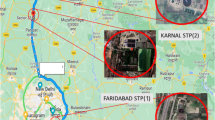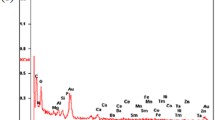Abstract
A 2-year sampling campaign was conducted in three wastewater treatment plants of various sizes in the Rome area to assess the occurrence of nutrients and micropollutants among primary, secondary and digested sludge. The primary purpose was to evaluate the quality of different sludge types and their suitability for agricultural use. Primary sludge was consistently more polluted than secondary in terms of organic micropollutants, whereas heavy metals partitioned equally among the sludge types. In digested sludge, the heavy metal concentrations were always below limit values proposed for agricultural utilisation. In contrast, organic micropollutants concentrated during anaerobic digestion and affected the quality of the digested sludge. Secondary sludge resulted less polluted and richer in nitrogen and phosphorus (up to three times) than primary sludge and is hence more suitable for agricultural use. Separate processing of primary and secondary sludge might therefore be an innovative option for sludge management that could maximise the possibilities of agricultural use of secondary sludge and limit disposal problems only to primary sludge. In fact, primary sludge could be easily treated and disposed of by conventional processes including thickening, anaerobic digestion, centrifugation and incineration, whereas the difficult digestibility of secondary sludge could be improved by disintegration pre-treatment before stabilisation.






Similar content being viewed by others
References
Alonso Alvarez E, Callejon Mochòn M, Jiménez Sànchez JC, Ternero Rodriguéz M (2002) Heavy metal extractable forms in sludge from wastewater treatment plants. Chemosphere 47:765–775
Aparicio I, Santos JL, Alonso E (2009) Limitation of the concentration of organic pollutants in sewage sludge for agricultural purposes: a case study in South Spain. Waste Manage 29:1747–1753
APHA, AWWA, WEF (1998) Standard methods for the examination of water and wastewater, 20th edn. American Public Health Association and American Water Works Association and Water Environment Federation, Washington DC
Barret M, Cea Barcia G, Guillon A, Carrère H, Patureau D (2010) Influence of feed characteristics on the removal of micropollutants during the anaerobic digestion of contaminated sludge. J Hazard Mater 181:241–247
Braguglia CM, Gianico A, Mininni G (2011) Laboratory-scale ultrasound pre-treated digestion of sludge: heat and energy balance. Bioresour Technol 102(16):7567–7573
Campbell HW (2000) Sludge management—future issues and trends. Water Sci Technol 41(8):1–8
Carballa M, Omil F, Ternes T, Lema JM (2007) Fate of pharmaceutical and personal care products (PPCPs) during anaerobic digestion of sewage sludge. Water Res 41(10):2139–2150
Chang GR, Liu JC, Lee DJ (2001) Co-conditioning and dewatering of chemical sludge and waste activated sludge. Water Res 35(3):786–794
Chipasa KB (2003) Accumulation and fate of selected heavy metals in a biological wastewater treatment system. Waste Manage 23:135–143
Comber SDW, Gunn AM (1996) Heavy metals entering sewage-treatment works from domestic sources. Water Environ J 10(2):137–142
Di Corcia A, Samperi R, Bellioni A, Marcomini A, Zanette M, Lemr K, Cavalli L (1994) LAS pilot study at the Roma-Nord sewage treatment plant and in the Tiber river. Riv Ital Sostanze Grasse 71(9):467–475
European Commission (2000) Working document on sludge. 3rd draft. ENV.E.3/LM
Garcìa-Gil JC, Plaza C, Senesi N, Brunetti G (2004) Effects of sewage sludge amendment on humic acids and microbiological properties of a semiarid Mediterranean soil. Biol Fertil Soils 39:320–328
Goi D, Tubaro F, Dolcetti G (2006) Analysis of metals and EOX in sludge from municipal wastewater treatment plants: a case study. Waste Manage 26:167–175
Gomez Rico MF, Font R, Aracil I, Fullana A (2007) Analysis of organic pollutants in sewage sludge from the Valencian Community (Spain). Arch Environ Contam Toxicol 52:306–316
Gómez-Canela C, Barth JAC, Lacorte S (2012) Occurrence and fate of perfluorinated compounds in sewage sludge from Spain and Germany. Environ Sci Pollut Res 19:4109–4119
González MM, Martín J, Camacho-Muñoz D, Santos JL, Aparicio I, Alonso E (2012) Degradation and environmental risk of surfactants after the application of compost sludge to the soil. Waste Manage 32:1324–1331
Guillemet TA, Maesen P, Delcarte E, Lognay GC, Gillet A, Claustriaux JJ, Culot M (2009) Factors influencing microbiological and chemical composition of South-Belgian raw sludge. Biotechnol Agron Soc Environ 13(2):249–255
Harrison EZ, Oakes SR, Hysell M, Hay A (2006) Organic chemicals in sewage sludges. Sci Total Environ 367:481–497
Heidler J, Sapkota A, Halden RU (2006) Partitioning, persistence, and accumulation in digested sludge of the topical antiseptic Triclocarban during wastewater treatment. Environ Sci Technol 40:3634–3639
Henning BJ, Snyman HG, Aveling TAS (2001) Plant–soil interactions of sludge-borne heavy metals and the effect on maize (Zea mays L.) seedling growth. Water S Afr 27(1):71–78
ICON (2001) Pollutants in urban waste water and sewage sludge. Final Report. IC Consultants Ltd, London UK http://ec.europa.eu/environment/waste/sludge/pdf/sludge_pollutants.pdf
Ifelebuegu AO (2011) The fate and behavior of selected endocrine disrupting chemicals in full scale wastewater and sludge treatment unit processes. Int J Environ Sci Tech 8(2):245–254
JRC Joint research centre EU commission (2006) http://eusoils.jrc.ec.europa.eu/esdb_archive/eusoils_docs/other/EUR22265_1.pdf
Karvelas M, Katsoyiannis A, Samara C (2003) Occurrence and fate of heavy metals in the wastewater treatment process. Chemosphere 53:1201–1210
Katsoyiannis A, Samara C (2005) Persistent organic pollutants (POPs) in the conventional activated sludge treatment process: fate and mass balance. Environ Res 97:245–257
Khan SJ, Ongerth JE (2002) Estimation of pharmaceutical residues in primary and secondary sewage sludge based on quantities of use and fugacity modelling. Water Sci Technol 46(3):105–113
Korentejar L (1991) A review of the agricultural use of sewage sludge: benefits and potential hazards. Water S Afr 17(3):189–196
Körner W, Bolz U, Sübmuth W, Hiller G, Schuller W, Hanf V (2000) Input/output balance of estrogenic active compounds in a major municipal sewage plant in Germany. Chemosphere 40:1131–1142
McGowin AE, Adom KK, Obubuafo AK (2001) Screening of compost for PAHs and pesticides using static subcritical water extraction. Chemosphere 45:857–864
Metcalf, Eddy (2003) Wastewater engineering: treatment and reuse, 4th edn. McGraw-Hill, New York
Mininni G, Braguglia CM, Ramadori R, Tomei MC (2004) An innovative sludge management system based on separation of primary and secondary sludge treatment. Water Sci Technol 50(9):145–153
Passuello A, Mari M, Nadal M, Schuhmacher M, Domingo JL (2010) POP accumulation in the food chain: integrated risk model for sewage sludge application in agricultural soils. Environ Int 36(6):577–583
Prats D, Ruiz F, Vazquez B, Rodriguez-Pastor M (1997) Removal of anionic and non-ionic surfactants in a wastewater treatment plant with anaerobic digestion. A comparative study. Water Res 31(8):1925–1930
Radjenovic J, Jelic A, Petrovic M, Barcelo D (2009) Determination of pharmaceuticals in sewage sludge by pressurized liquid extraction (PLE) coupled to liquid chromatography–tandem mass spectrometry (LC-MS/MS). Anal Bioanal Chem 393:1685–1695
Roig N, Sierra J, Nadal M, Martí E, Navalón-Madrigal P, Schuhmacher M, Domingo JL (2012) Relationship between pollutant content and ecotoxicity of sewage sludges from Spanish wastewater treatment plants. Sci Total Environ 425:99–109
Roy M, Couillard D (1998) Metal leaching following sludge application to a deciduous forest soil. Water Res 32:1642–1652
Salsabil MR, Laurent J, Casellas M, Dagot C (2010) Techno-economic evaluation of thermal treatment, ozonation and sonication for the reduction of wastewater biomass volume before aerobic or anaerobic digestion. J Hazard Mater 174:323–333
Ternes TA, Joss A, Siegrist H (2004) Scrutinizing pharmaceuticals and personal care products in wastewater treatment. The complexity of these hazards should not be underestimated. Environ Sci Technol 38(20):392–399
US EPA (1979) Process design manual for sludge treatment and disposal. US EPA, Washington, DC
Villar P, Callejón M, Alonso E, Jimenez JC, Guiraúm A (2006) Temporal evolution of polycyclic aromatic hydrocarbons (PAHs) in sludge from wastewater treatment plants: comparison between PAHs and heavy metals. Chemosphere 64(4):535–541
Villar M, Callejón M, Villar P, Fernández-Torres R, Bello MA, Guiraúm A (2011) Temporal evolution of linear alkylbenzene sulfonates and heavy metals in sludge from wastewater treatment plant. Water Environ Res 83(5):411–417
Wang C, Li X-C, Ma H-T, Qian J, Zhai J-B (2006) Distribution of extractable fractions of heavy metals in sludge during the wastewater treatment process. J Hazard Mater 137:1277–1283
Winter P, Pearce P (2010) Parallel digestion of secondary and primary sludge. In Proceedings of the 15th European biosolids and organic resources conference, November 2010 NJ Horan ed, Aqua Enviro, Leeds
Acknowledgments
This research activity was funded by the European FP6 project Neptune (http://www.eu-neptune.org/index_EN) “New Sustainable Concepts and Processes for Optimisation and Upgrading Municipal Wastewater and Sludge Treatment.”
The monitoring campaign of the Italian WWTPs was conducted with the kind assistance and cooperation of ACEA s.p.a., the Municipal Agency for Electricity and the Environment.
The micropollutant analyses were performed in kind cooperation with Domenico Mastroianni, Giuseppe Bagnuolo and Ruggero Ciannarella at IRSA-CNR of Rome and Bari, respectively.
Author information
Authors and Affiliations
Corresponding author
Additional information
Responsible editor: Céline Guéguen
Rights and permissions
About this article
Cite this article
Gianico, A., Braguglia, C.M., Mascolo, G. et al. Partitioning of nutrients and micropollutants along the sludge treatment line: a case study. Environ Sci Pollut Res 20, 6256–6265 (2013). https://doi.org/10.1007/s11356-013-1686-x
Received:
Accepted:
Published:
Issue Date:
DOI: https://doi.org/10.1007/s11356-013-1686-x




